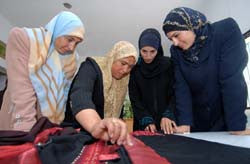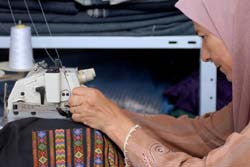Idna Ladies' Association
 Location: Idna village, southern West Bank
Location: Idna village, southern West Bank
Beneficiaries: 50 women

Idna is a remote village located in the hills southwest of the Palestinian city of Hebron. Despite its beautiful hillsides, the village suffers from critical unemployment, adult illiteracy, and inadequate health and educational facilities.
The Idna Ladies’ Association (estab. 1998) began as a small local income-generation project for women to learn skills in product design, sewing, quality control, inventory, financial management and organisational skills. The Association has since grown from one room to a workshop equipped with sewing machines and worktables. The Idna ladies are well-known for their original products of exceptional prettiness and practicality.
Many women in Idna village are the sole family breadwinner. Their work with the Association means many are now able to provide their daughters with opportunities for higher education that they themselves were not able to do.
View our product range from the Idna Ladies' Association here >>
These products are certified Fair Trade: creating opportunities for disadvantaged producers, sustaining fair working conditions and wages, empowering women, and preserving traditional crafts and artisan skills.

Cross-stitch embroidery in Palestine
Once a traditional craft practiced by village women, Palestinian cross-stitch embroidery has become an important symbol of Palestinian culture. Embroidered pieces can be found in the homes of most Palestinian families in the West Bank, Gaza Strip, Israel and the Diaspora beyond, adorning the walls of houses in Jerusalem, villas in the Gulf, suburban homes in the United States, and cement block houses in refugee camps. In addition, cross-stitch embroidery is given as gifts and worn by Palestinians worldwide on festive occasions.
The popularity of embroidery springs from both its beauty and its association with the Palestine of the past. Common patterns reflect the millennia-long history of the land. The designs are derived from sources as diverse as ancient mythology and foreign occupations and date as far back as the Canaanites, who lived in the area over three thousand years ago.
The handicraft also symbolises the traditional rural lifestyle of Palestine, much of which was lost after the 1948 creation of the state of Israel. Embroidery was the principal decoration of rural women's clothing. It was part of a village women's daily routine and a means of showing off her personal skills and social identity. The patterns, colours and quality of the dress reflected a woman's social standing, marital status and wealth.
Although the Palestinian cultural landscape has changed dramatically in the last fifty years, cross-stitch embroidery has remained a vibrant handicraft because, for many Palestinians, it is a familiar reminder of Palestine in the days of their grandparents or great-grandparents.
